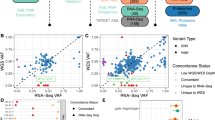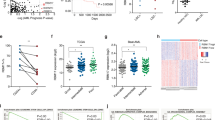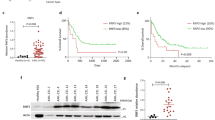Abstract
Mutations resulting in constitutive activation of signaling pathways that regulate ribosome biogenesis are among the most common genetic events in acute myeloid leukemia (AML). However, whether ribosome biogenesis presents as a therapeutic target to treat AML remains unexplored. Perturbations in ribosome biogenesis trigger the 5S ribonucleoprotein particle (RNP)–Mdm2–p53 ribosomal stress pathway, and induction of this pathway has been shown to have therapeutic efficacy in Myc-driven lymphoma. In the current study we address the physiological and therapeutic role of the 5S RNP–Mdm2–p53 pathway in AML. By utilizing mice that have defective ribosome biogenesis due to downregulation of ribosomal protein S19 (Rps19), we demonstrate that induction of the 5S RNP–Mdm2–p53 pathway significantly delays the initiation of AML. However, even a severe Rps19 deficiency that normally results in acute bone marrow failure has no consistent efficacy on already established disease. Finally, by using mice that harbor a mutation in the Mdm2 gene disrupting its binding to 5S RNP, we show that loss of the 5S RNP–Mdm2–p53 pathway is dispensable for development of AML. Our study suggests that induction of the 5S RNP–Mdm2–p53 ribosomal stress pathway holds limited potential as a single-agent therapy in the treatment of AML.
This is a preview of subscription content, access via your institution
Access options
Subscribe to this journal
Receive 12 print issues and online access
$259.00 per year
only $21.58 per issue
Buy this article
- Purchase on SpringerLink
- Instant access to full article PDF
Prices may be subject to local taxes which are calculated during checkout





Similar content being viewed by others
References
Deisenroth C, Zhang Y . The ribosomal protein-Mdm2-p53 pathway and energy metabolism: bridging the gap between feast and famine. Genes Cancer 2011; 2: 392–403.
Vousden KH, Prives C . Blinded by the light: the growing complexity of p53. Cell 2009; 137: 413–431.
Sloan KE, Bohnsack MT, Watkins NJ . The 5 S RNP couples p53 homeostasis to ribosome biogenesis and nucleolar stress. Cell Rep 2013; 5: 237–247.
Donati G, Peddigari S, Mercer CA, Thomas G . 5 S ribosomal RNA is an essential component of a nascent ribosomal precursor complex that regulates the Hdm2-p53 checkpoint. Cell Rep 2013; 4: 87–98.
Liu Y, He Y, Jin A, Tikunov AP, Zhou L, Tollini LA et al. Ribosomal protein-Mdm2-p53 pathway coordinates nutrient stress with lipid metabolism by regulating MCD and promoting fatty acid oxidation. Proc Natl Acad Sci USA 2014; 111: E2414–E2422.
Macias E, Jin A, Deisenroth C, Bhat K, Mao H, Lindström MS et al. An ARF-independent c-MYC-activated tumor suppressor pathway mediated by ribosomal protein-Mdm2 interaction. Cancer Cell 2010; 18: 231–243.
Ruggero D, Pandolfi PP . Does the ribosome translate cancer? Nat Rev Cancer 2003; 3: 179–192.
Hannan KM, Sanij E, Hein N, Hannan RD, Pearson RB . Signaling to the ribosome in cancer—It is more than just mTORC1. IUBMB Life 2011; 63: 79–85.
Barna M, Pusic A, Zollo O, Costa M, Kondrashov N, Rego E et al. Suppression of Myc oncogenic activity by ribosomal protein haploinsufficiency. Nature 2008; 456: 971–975.
Bywater MJ, Poortinga G, Sanij E, Hein N, Peck A, Cullinane C et al. Inhibition of RNA polymerase I as a therapeutic strategy to promote cancer-specific activation of p53. Cancer Cell 2012; 22: 51–65.
The Cancer Genome Atlas Research Network. Genomic and epigenomic landscapes of adult de novo acute myeloid leukemia. N Engl J Med 2013; 368: 2059–2074.
Armstrong SA, Staunton JE, Silverman LB, Pieters R, den Boer ML, Minden MD et al. MLL translocations specify a distinct gene expression profile that distinguishes a unique leukemia. Nat Genet 2002; 30: 41–47.
Jiang X, Huang H, Li Y, Wang X, Gurbuxani S, Chen P et al. Blockade of miR-150 maturation by MLL-fusion/MYC/Lin-28 is required for MLL-associated leukemia. Cancer Cell 2012; 22: 524–535.
Levine AJ . P53, the cellular gatekeeper for growth and division. Cell 1997; 88: 323–331.
Fenaux P, Preudhomme C, Quiquandon I, Jonveaux P, Laï JL, Vanrumbeke M et al. Mutations in the P53 gene in acute myeloid leukaemia. Br J Haematol 1992; 80: 178–183.
Jaako P, Flygare J, Olsson K, Quere R, Ehinger M, Henson A et al. Mice with ribosomal protein S19 deficiency develop bone marrow failure and symptoms like patients with Diamond-Blackfan anemia. Blood 2011; 118: 6087–6096.
Jaako P, Debnath S, Olsson K, Zhang Y, Flygare J, Lindström MS et al. Disruption of the 5 S RNP-Mdm2- interaction significantly improves the erythroid defect in a mouse model for Diamond-Blackfan anemia. Leukemia 2015; 29: 2221–2229.
Ugale A, Norddahl GL, Wahlestedt M, Säwén P, Jaako P, Pronk CJ et al. Hematopoietic stem cells are intrinsically protected against MLL-ENL-mediated transformation. Cell Rep 2014; 9: 1246–1255.
Jaako P, Debnath S, Olsson K, Modlich U, Rothe M, Schambach A et al. Gene therapy cures the anemia and lethal bone marrow failure in a mouse model for RPS19-deficient Diamond-Blackfan anemia. Haematologica 2014; 99: 1792–1798.
Lawrence HJ, Rozenfeld S, Cruz C, Matsukuma K, Kwong A, Kömüves L et al. Frequent co-expression of the HOXA9 and MEIS1 homeobox genes in human myeloid leukemias. Leukemia 1999; 13: 1993–1999.
Kroon E, Krosl J, Thorsteindottir U, Baban S, Buchberg AM, Sauvageau G . Hoxa9 transforms primary bone marrow cells through specific collaboration with Meis1a but not Pbx1b. EMBO J 1998; 17: 3714–3725.
Liu H, Cheng EH, Hsieh JJ . MLL fusions: pathways to leukemia. Cancer Biol Ther 2009; 8: 1204–1211.
Milne TA, Dou Y, Martin ME, Brock HW, Roeder RG, Hess JL . MLL associates specifically with a subset of transcriptionally active target genes. Proc Natl Acad Sci USA 2005; 102: 13765–14770.
Haferlach T, Kohlmann A, Wieczorek L, Basso G, Kronnie GT, Béné MC et al. Clinical utility of microarray-based gene expression profiling in the diagnosis and subclassification of leukemia: report from the International Microarray Innovations in Leukemia Study Group. J Clin Oncol 2010; 28: 2529–2537.
Signer RA, Magee JA, Salic A, Morrison SJ . Haematopoietic stem cells require a highly regulated protein synthesis rate. Nature 2014; 409: 49–54.
Mendrysa SM, McElwee MK, Michalowski J, O’Leary KA, Young KM, Perry ME . Mdm2 is critical for inhibition of p53 during lymphopoiesis and the response to ionizing irradiation. Mol Cell Biol 2003; 23: 462–472.
Tyner SD, Venkatachalam S, Choi J, Jones S, Ghebranious N, Igelmann H et al. p53 mutant mice that display early ageing-associated phenotypes. Nature 2002; 415: 45–53.
Vlachos A, Ball S, Dahl N, Alter BP, Sheth S, Ramenghi U et al. Diagnosing and treating Diamond Blackfan anaemia: results of an international clinical consensus conference. Br J Haematol 2008; 142: 859–876.
Draptchinskaia N, Gustavsson P, Andersson B, Pettersson M, Willig TN, Dianzani I et al. The gene encoding ribosomal protein S19 is mutated in Diamond-Blackfan anaemia. Nat Genet 1999; 21: 169–175.
Vlachos A, Rosenberg PS, Atsidaftos E, Alter BP, Lipton JM . Incidence of neoplasia in Diamond Blackfan anemia: a report from the Diamond Blackfan Anemia Registry. Blood 2012; 119: 3815–3819.
Acknowledgements
We thank Dr Guy Sauvageau (Université de Montréal) for kindly providing the MSCV-Hoxa9-Meis1 vector. We thank Shamit Soneji (Lund University) for the bioinformatic support. This work was supported by The Swedish Children’s Cancer Society (to PJ), The Crafoord Foundation (to PJ), The Gunnar Nilsson Cancer Foundation (to DB and PJ), The Swedish Research Council (to DB and MSL), the Swedish Cancer Society (to DB) and ERC Consolidator grant 615068 (to DB).
Author information
Authors and Affiliations
Corresponding author
Ethics declarations
Competing interests
The authors declare no conflict of interest.
Additional information
Supplementary Information accompanies this paper on the Leukemia website
Supplementary information
Rights and permissions
About this article
Cite this article
Jaako, P., Ugale, A., Wahlestedt, M. et al. Induction of the 5S RNP–Mdm2–p53 ribosomal stress pathway delays the initiation but fails to eradicate established murine acute myeloid leukemia. Leukemia 31, 213–221 (2017). https://doi.org/10.1038/leu.2016.159
Received:
Revised:
Accepted:
Published:
Issue date:
DOI: https://doi.org/10.1038/leu.2016.159
This article is cited by
-
The nucleolus, an ally, and an enemy of cancer cells
Histochemistry and Cell Biology (2018)



